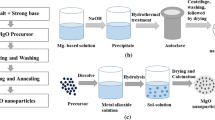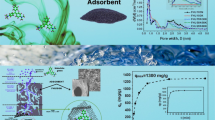Abstract
The synthesis of three kinds of sorbents is described. The first kind was a hydrophobic nanofiber as a specific sorbent for non-polar compounds. The second one was a hydrophilic nanofiber as a specific sorbent for polar compounds and the third one was a generic sorbent synthesized from hydrophilic and hydrophobic compounds. The functional groups were natural compounds extracted from aloin plant and gum of pine tree. The aloin/polyacrylonitrile (PAN), rosin/PAN, and aloin/rosin/PAN electrospun nanofibers were synthesized through electrospinning strategy and then characterized using field emission scanning electron microscopy and Fourier transform infrared spectroscopy. Thereafter, the synthesized sorbents were used in microextraction using the packed syringe (MEPS) method. The determination was conducted using gas chromatography with flame ionization detection (GC-FID). Under the optimum condition, the method using aloin/rosin/PAN nanofibers as a sorbent showed a good linearity in the range 1.0–250 ng mL−1 for polycyclic aromatic hydrocarbons (PAHs) (as a model for non-polar compounds) and 1.0–200 ng mL−1 for phenoxyacetic acid herbicides (CAPs) (as a model for polar compounds) with correlation coefficient (R2) higher than 0.997. Limits of detections (LODs) for PAHs and CAPs were in the range 0.1–0.3 ng mL−1 and 0.3–0.5 ng mL−1, respectively. The intra-day (n = 3) and inter-day (between 3 days) relative standard deviations (RDSs%) were in the range 6.3–12.3% for a single syringe. Finally, the MEPS-GC-FID method was applied as a simple, facile, and time and cost-effective method to analyze environmental, farm, and industrial water samples.

Herein, aloin/rosin/polyacrylonitrile (PAN) electrospun nanofiber was successfully synthesized and applied as a sorbent for extraction of polycyclic aromatic hydrocarbons (PAHs) as non-polar compounds and phenoxyacetic acid herbicides (CPAs) as polar compounds from aqueous solutions before GC-FID analysis.





Similar content being viewed by others
References
Abdel-Rehim M (2004) New trend in sample preparation: on-line microextraction in packed syringe for liquid and gas chromatography applications: I. Determination of local anaesthetics in human plasma samples using gas chromatography–mass spectrometry. J Chromatogr B 801(2):317–321
Yang L, Said R, Abdel-Rehim M (2017) Sorbent, device, matrix and application in microextraction by packed sorbent (MEPS): a review. J Chromatogr B 1043:33–43
Mousavi KZ, Yamini Y, Karimi B, Seidi S, Khorasani M, Ghaemmaghami M, Vali H (2019) Imidazolium-based mesoporous organosilicas with bridging organic groups for microextraction by packed sorbent of phenoxy acid herbicides, polycyclic aromatic hydrocarbons and chlorophenols. Microchim Acta 186(4):239
Mehrani Z, Ebrahimzadeh H, Asgharinezhad AA (2018) Synthesis and characterization of a poly (p-phenylenediamine)-based electrospun nanofiber for the micro-solid-phase extraction of organophosphorus pesticides from drinking water and lemon and orange juice samples. J Sep Sci 41(17):3477–3485
Moradi E, Ebrahimzadeh H, Mehrani Z (2019) Electrospun acrylonitrile butadiene styrene nanofiber film as an efficient nanosorbent for head space thin film microextraction of polycyclic aromatic hydrocarbons from water and urine samples. Talanta 205:120080
Karimiyan H, Uheida A, Hadjmohammadi M, Moein MM, Abdel-Rehim M (2019) Polyacrylonitrile/graphene oxide nanofibers for packed sorbent microextraction of drugs and their metabolites from human plasma samples. Talanta 201:474–479
Yan Z, Hu B, Li Q, Zhang S, Pang J, Wu C (2019) Facile synthesis of covalent organic framework incorporated electrospun nanofiber and application to pipette tip solid phase extraction of sulfonamides in meat samples. J Chromatogr A 1584:33–41
Chigome S, Torto N (2011) A review of opportunities for electrospun nanofibers in analytical chemistry. Anal Chim Acta 706(1):25–36
Rojanarata T, Plianwong S, Su-uta K, Opanasopit P, Ngawhirunpat T (2013) Electrospun cellulose acetate nanofibers as thin layer chromatographic media for eco-friendly screening of steroids adulterated in traditional medicine and nutraceutical products. Talanta 115:208–213
Háková M, Raabová H, Havlíková LC, Chocholouš P, Chvojka J, Šatínský D (2018) Testing of nylon 6 nanofibers with different surface densities as sorbents for solid phase extraction and their selectivity comparison with commercial sorbent. Talanta 181:326–332
Song M, Pan C, Li J, Zhang R, Wang X, Gu Z (2008) Blends of TiO2 nanoparticles and poly (N-isopropylacrylamide)-co-polystyrene nanofibers as a means to promote the biorecognition of an anticancer drug. Talanta 75(4):1035–1040
Li D, Gu Y, Xu X, Feng Y, Ma Y, Li S, Yao C (2019) Electrospun polyacrylonitrile fibers with and without magnetic nanoparticles for selective and efficient separation of glycoproteins. Microchim Acta 186(8):542
Liu F, Xu H (2017) Development of a novel polystyrene/metal-organic framework-199 electrospun nanofiber adsorbent for thin film microextraction of aldehydes in human urine. Talanta 162:261–267
Asiabi M, Mehdinia A, Jabbari A (2017) Spider-web-like chitosan/MIL-68 (Al) composite nanofibers for high-efficient solid phase extraction of Pb (II) and Cd (II). Microchim Acta 184(11):4495–4501
Abdo HS, Khalil KA, El-Rayes MM, Marzouk WW, Hashem A, Abdel-Jaber G (2019) Ceramic nanofibers versus carbon nanofibers as a reinforcement for magnesium metal matrix to improve the mechanical properties. Journal of King Saud University-Engineering Sciences
Han W, Ding B, Park M, Cui F, Ghouri ZK, Saud PS, Kim H-Y (2015) Facile synthesis of luminescent and amorphous La 2 O 3–ZrO 2: Eu 3+ nanofibrous membranes with robust softness. Nanoscale 7(34):14248–14253
Moschet C, Piazzoli A, Singer H, Hollender J (2013) Alleviating the reference standard dilemma using a systematic exact mass suspect screening approach with liquid chromatography-high resolution mass spectrometry. Anal Chem 85(21):10312–10320
Zeinali S, Khalilzadeh M, Bagheri H (2019) Generic extraction medium: from highly polar to non-polar simultaneous determination. Anal Chim Acta 1066:1–12
Vuckovic D, Pawliszyn J (2011) Systematic evaluation of solid-phase microextraction coatings for untargeted metabolomic profiling of biological fluids by liquid chromatography− mass spectrometry. Anal Chem 83(6):1944–1954
Allan IJ, Harman C, Ranneklev SB, Thomas KV, Grung M (2013) Passive sampling for target and nontarget analyses of moderately polar and nonpolar substances in water. Environ Toxicol Chem 32(8):1718–1726
Pan L, Pawliszyn J (1997) Derivatization/solid-phase microextraction: new approach to polar analytes. Anal Chem 69(2):196–205
Kaith B, **dal R, Sharma R (2015) Synthesis of a gum rosin alcohol-poly (acrylamide) based adsorbent and its application in removal of malachite green dye from waste water. RSC Adv 5(54):43092–43104
Yebra DM, Kiil S, Dam-Johansen K, Weinell C (2005) Reaction rate estimation of controlled-release antifouling paint binders: rosin-based systems. Progress in Organic Coatings 53(4):256–275
Esmat AY, Said MM, Khalil SA (2015) Aloin: a natural antitumor anthraquinone glycoside with iron chelating and non-atherogenic activities. Pharm Biol 53(1):138–146
Di Prima G, Conigliaro A, De Caro V (2019) Mucoadhesive polymeric films to enhance barbaloin penetration into buccal mucosa: a novel approach to chemoprevention. AAPS PharmSciTech 20(1):18
Huang J, Deng H, Song D, Xu H (2015) Electrospun polystyrene/graphene nanofiber film as a novel adsorbent of thin film microextraction for extraction of aldehydes in human exhaled breath condensates. Anal Chim Acta 878:102–108
Wang M, Li X, Hua W, Shen L, Yu X, Wang X (2016) Electrospun poly (acrylic acid)/silica hydrogel nanofibers scaffold for highly efficient adsorption of lanthanide ions and its photoluminescence performance. ACS Appl Mater Interfaces 8(36):23995–24007
Mehrani Z, Ebrahimzadeh H, Aliakbar AR, Asgharinezhad AA (2018) A poly (4-nitroaniline)/poly (vinyl alcohol) electrospun nanofiber as an efficient nanosorbent for solid phase microextraction of diazinon and chlorpyrifos from water and juice samples. Microchim Acta 185(8):384
Pei M, Shi X, Wu J, Huang X (2019) Graphene reinforced multiple monolithic fiber solid-phase microextraction of phenoxyacetic acid herbicides in complex samples. Talanta 191:257–264
Gutiérrez-Serpa A, Napolitano-Tabares PI, Pino V, Jiménez-Moreno F, Jiménez-Abizanda AI (2018) Silver nanoparticles supported onto a stainless steel wire for direct-immersion solid-phase microextraction of polycyclic aromatic hydrocarbons prior to their determination by GC-FID. Microchim Acta 185(7):341
Ma X, Huang P, Dang X, Ai Y, Zheng D, Chen H (2019) MWCNTs/MnO2 nanocomposite-based polythiophene coating for solid-phase microextraction and determination of polycyclic aromatic hydrocarbons in soil. Microchem J 146:1026–1032
Yamini Y, Saleh A (2013) Ultrasound-assisted emulsification microextraction combined with injection-port derivatization for the determination of some chlorophenoxyacetic acids in water samples. J Sep Sci 36(14):2330–2338
Author information
Authors and Affiliations
Corresponding author
Ethics declarations
Conflict of interest
The authors declare that they have no competing interests.
Additional information
Publisher’s note
Springer Nature remains neutral with regard to jurisdictional claims in published maps and institutional affiliations.
Electronic supplementary material
ESM 1
(DOCX 723 kb)
Rights and permissions
About this article
Cite this article
Mehrani, Z., Ebrahimzadeh, H. & Moradi, E. Use of aloin-based and rosin-based electrospun nanofibers as natural nanosorbents for the extraction of polycyclic aromatic hydrocarbons and phenoxyacetic acid herbicides by microextraction in packed syringe method prior to GC-FID detection. Microchim Acta 187, 401 (2020). https://doi.org/10.1007/s00604-020-04374-9
Received:
Accepted:
Published:
DOI: https://doi.org/10.1007/s00604-020-04374-9




